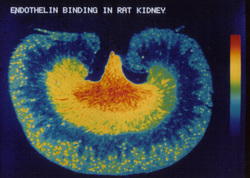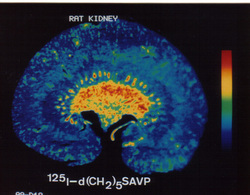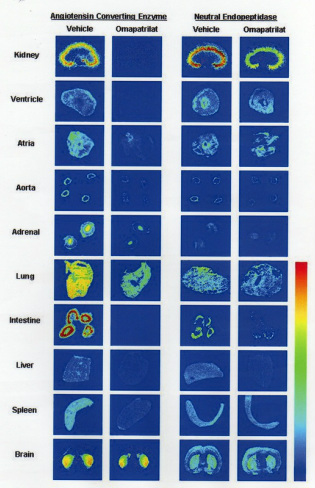Autoradiography Receptors and Enzymes
Autoradiography

Autoradiography is a laboratory technique whereby substances can be located in tissues, gels etc. by making them radioactive. They are localized and their concentration is determined by the intensity of exposure when stored against radiation sensitive material such as X-ray film. Once developed, the image on the exposed film can be captured by an MCID video camera. Once on computer, the digital image can be transferred from black and white to colors of the rainbow to reflect intensity. The image can be digitally enhanced and the back ground can be subtracted. The intensity can be measured by including radioactive standards in the exposure cassette which equate the exposure to radioactive counts. If the specific activity of the substance is known its presence can be reported in terms of mass present. More specifically, tissue autoradiography uses physiological or pharmacological substances made radioactive and are added to tissues in-vitro or in-vivo.
Receptor Autoradiographic Localization
 When the physiological substances are hormones or the pharmacological substances are hormone agonists or antagonists and they bind to that hormone’s receptors, we call this receptor autoradiographic localization. The technique can be used to study receptor numbers and density. We can examine ‘on’ and ‘off’ times, the effect of competition binding, up regulation and down regulation of receptors and congenital or acquired faults/defects in the receptors. The science has resulted in an enormous boost to our understanding of hormones and growth factors over the last 30 years. New receptors and hormone are still being discovered and its application goes well beyond this field. The same technique can be used to localize and characterize enzymes e.g. ACE, NEP by their ability to bind radio inhibitors or their natural substrates. New fields like cancer research are only just starting to benefit from this application of radioactively labelled ligand studies.
When the physiological substances are hormones or the pharmacological substances are hormone agonists or antagonists and they bind to that hormone’s receptors, we call this receptor autoradiographic localization. The technique can be used to study receptor numbers and density. We can examine ‘on’ and ‘off’ times, the effect of competition binding, up regulation and down regulation of receptors and congenital or acquired faults/defects in the receptors. The science has resulted in an enormous boost to our understanding of hormones and growth factors over the last 30 years. New receptors and hormone are still being discovered and its application goes well beyond this field. The same technique can be used to localize and characterize enzymes e.g. ACE, NEP by their ability to bind radio inhibitors or their natural substrates. New fields like cancer research are only just starting to benefit from this application of radioactively labelled ligand studies.
ACE and NEP Localization Using Radioinhibitors

Some of the most popular radioligands we make and the receptors they bind to are:-
RADIOLIGAND RECEPTOR USUAL HORMONE
125I-Sar1 Ile8 Angiotensin II AT1 Angiotensin-II
125I-CGP42112 AT2 Angiotensin-II
125I-HPP-HOE140 BKB2 Bradykinin
125I-SAVP V1a Vasopressin
125I-Nle Ang-IV AT4 Angiotensin-IV
125I-Cyanopindolol 5-HT1A/1B & ß-adrenoceptor
125I HEAT α1A adrenoceptor
Any of the natural hormones once iodinated can be used to locate and study their native receptor:- e.g. ET1, ANP, Ang-II, Ang-(1-7),
About ACE and NEP Localization.
When the radio ligand is an enzyme inhibitor autoradiography can be use to localize and characterize the activity of enzymes or assess their degree of inhibition by other competitive inhibitors. Our lab has had a lot to do with the study of ACE and NEP (Neprilysin) location in tissues and we still make the radio inhibitors for this. These same radio inhibitors can also be used in Radio Inhibitor Binding Assays (RIBA).
The radio inhibitors we make and the enzymes they bind to are:-
RADIOINHIBITOR ENZYME
125I-MK351 (HPP-enalaprilat) Angiotensin Converting Enzyme (ACE)
125I-SCH47896 Neutral endopeptidase (NEP) (Neprilysin)
